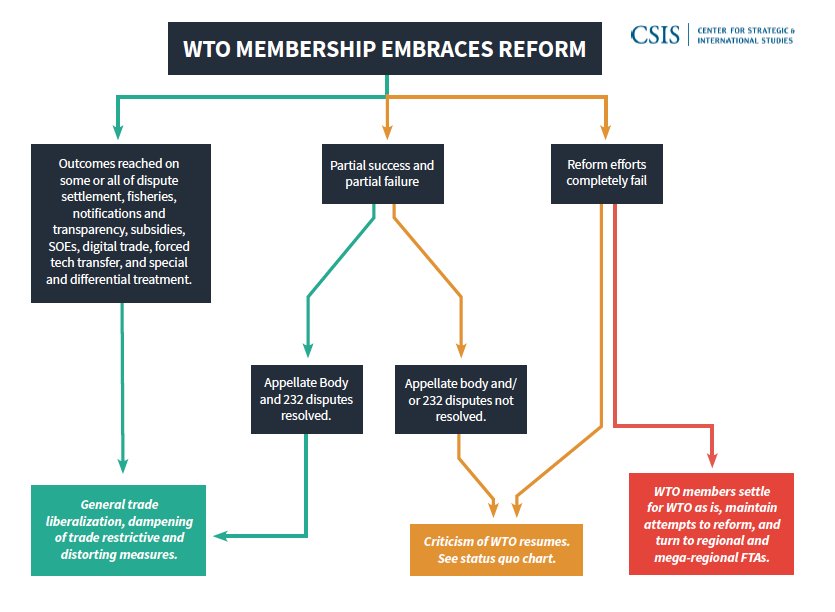The WTO At a Crossroad: Three Scenarios

The WTO At a Crossroad: Three Scenarios
Despite the invaluable role the World Trade Organization (WTO) has played in the global economy, it faces potentially fatal pressure from within and outside the organization. Within the WTO, the over 160 countries that compose its membership are mired in longstanding disagreements over a range of fundamental issues. Stuck in what have become intractable debates, the WTO is struggling to craft rules that grapple with modern trade issues, such as the digital economy. The WTO dispute settlement function will likely be kneecapped by the end of 2019. Outside of the WTO, technology is reshaping the global economy more quickly than negotiations in Geneva can keep pace. Economic nationalism is on the rise in countries that have typically supported free trade. China’s state-driven economic model, which is fundamentally at odds with WTO principles, has given rise to questions over the WTO’s ability to reshape the non-market activity of its members. The Trump administration’s attacks on the WTO Appellate Body, elastic use of the national security exception, and imposition of tariffs outside WTO processes have added further stress to the global trade system. It is clear that the WTO is at a crossroad.
There are three general directions the United States and WTO may take considering these challenges. Each direction carries multiple sub-scenarios: a continuation of the status quo, U.S. withdrawal from the WTO, and successful reform of the WTO. Only the reform scenario yields predictability and stability in global supply chains. The status quo and withdrawal scenarios will at a minimum generate business uncertainty and stymie investment and global growth but may encourage companies to invest in the United States to avoid fallout from withdrawal or erosion of the global trading system. The upside of that investment, however, would be limited by uncertain access to 95 percent of the global population that lives outside the United States.
Status Quo
The status quo scenario unfolds with continued attacks on the WTO while its members fail to resolve old disagreements and fail to negotiate rules on new issues. The WTO Appellate Body becomes inoperable in mid-December and the United States’ concerns over dispute settlement are unresolved, which throws dispute settlement—once the crown jewel of the WTO—into uncharted territory. As the WTO’s relevance fades and its ability to enforce its rules diminishes, members may begin to test the consequences of noncompliance with their WTO obligations. Decisions in pivotal disputes over U.S. national security tariffs on steel and aluminum as well as China’s non-market economy status could drive U.S. disengagement or even withdrawal from the WTO, although the latter dispute appears to be receding in importance for the time being. The headwinds of the status quo may also inspire the United States and other WTO members to rise to the occasion, salvage, and perhaps even reimagine the WTO. History has shown that the WTO tends to lurch from crisis to crisis only to be rescued at the last moment. Such an inflection point is approaching.

Withdrawal
The withdrawal scenario sees the United States pull out of the WTO. This scenario raises several legal and procedural questions that will influence the practical implications of withdrawal. Nonetheless, all the outcomes of the withdrawal scenario are harmful to global supply chains.

Reform
The reform scenario sees a resolution to several longstanding thorns in the side of the WTO, including issues of special and differential treatment for developing countries, notifications and transparency, and U.S. concerns over dispute settlement. The successful conclusion of negotiations for new rules on e-commerce, fisheries subsidies, state-owned enterprises, and industrial subsidies would reassert the WTO’s role in the modern global trade system and unlock a new wave of trade liberalization.

Notes
Despite the invaluable role the World Trade Organization (WTO) has played in the global economy, it faces potentially fatal pressure from within and outside the organization. This feature lays out three scenarios for the future of the WTO.